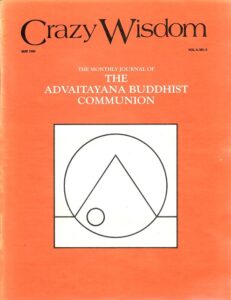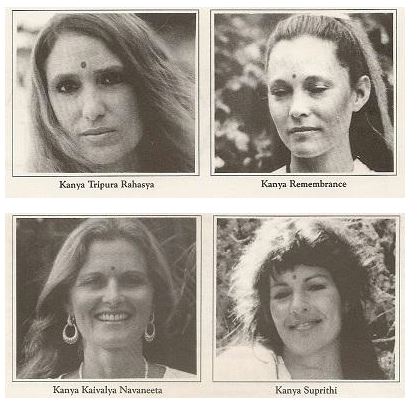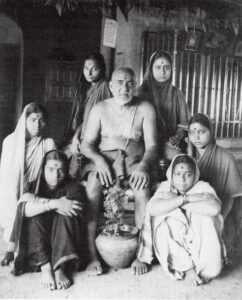

Free Renunciate Order
A talk by Da Love-Ananda (Adi Da Samraj), May 7, 1986
***
“It is to be seen whether many or very few will develop this practice in fully mature terms in my lifetime. But for the sake of all those to come in the future, at least a small but significant group of practitioners in The Free Renunciate Order must be developed as well as an institution that altogether functions well. Otherwise the means of Transmission to future generations will suffer, and the institution will tend to come under the control of people who are not fully involved in this Way or who have not fulfilled this Way to the point of Realization.”
‘The Fire Gospel’, 1982, p. 58
***
Free Renunciate Order
May 7, 1986
DA LOVE-ANANDA: Yesterday I asked the Free Renunciate Order to consider who if any among you was prepared to accept sannyas.2 It did not appear to be time for anyone in the broader membership of the Free Renunciate Order to take sannyas, but four devotees involved in direct service to me are prepared. They presented their consideration to me, and I accepted their confession. Therefore, yesterday was their sannyas Day.
Traditionally, a ceremony is associated with any individual’s taking of sannyas—as it will be in our case. However, the taking of sannyas is not equated with a ceremony, although the conventional taking of sannyas, in the routines of conventional religion, is very much identified with ceremonies. In our case and in the fullness of the Great Tradition, sannyas is a spiritual matter fundamentally. It is basically a matter of the consideration between the Master and his devotee. When the devotee shows all of the evidence of preparation for sannyas, the Master acknowledges it. Through that acknowledgment the person has received sannyasa diksha.3
The form of ritual celebration we will enact in our sannyas ceremonies will be of our own design, but will also borrow from the tradition of sannyas. On that occasion the community may give gifts appropriate for a sannyasin. Typically, gifts will consist of clothing and other practical necessities, or symbolic forms of one kind or another that the individual might wear or use—things associated with the renunciate and the spiritual Way of life in general, such as Murtis.
In addition to receiving my acknowledgment and wearing the traditional orange clothing, a sannyasin in our Way is given a renunciate name that has many parts to it as is described in my essay “The Order of Renunciate Names.”4 At least one portion of the name is personal to the individual, while the rest is made up of titles or designations
In the case of these four individuals, there is a title associated with each name that is not given in “The Order of Renunciate Names.” It seems to me that these four should be associated with a title that formally acknowledges their direct service to me, their direct response to me, their special Agency and expression of me to others, and their special confession and realization through their service to me.
2. The Sanskrit word “sannyasa” means literally “to throw down completely” or “to renounce”. Traditionally in India, sannyasa was seen as one of the four stages of human life, which included the student (“brahmacharya”), householder (“grihastha”), recluse or ascetic “forest dweller” (“vanaprastha”), and renouncer (“sannyasa”) stages. A “sannyasin” has completely renounced all worldly bonds and devoted himself or herself entirely to spiritual practice. In the Way that Da Love-Ananda Teaches, to take sannyas is to renounce even the bondage to spiritual and mystical experiences that would distract the devotee and delay the course of Realization.
3. The Sanskrit word “diksha” means literally “initiation, dedication, consecration”. Thus, “sannyasa diksha” is the initiation of the devotee by the Guru into the practice of sannyas, or radical renunciation and utter dedication to God-Realization.
4. “The Order of Renunciate Names” is one of the essays in The Call to Hermitage (forthcoming from The Dawn Horse Press).

Therefore, I want to give names formally to these four devotees today, and acknowledge to the community of devotees their reception of sannyasa diksha. The first part of the name is Swami. In the case of women who take sannyas in our Way this is followed by the title or designation Dama. In the case of men it is Daji. This is then followed by the specific name given to the individual, which could be in any language.
Of course, the meaning of this name should be associated with our Way of life and with sannyas. It should, in general, be a name that would be appropriate in the context of the seventh stage of life as well as at the time given. It may typically be given when the individual is practicing in the context of the sixth stage of life. The personal name would be followed by the designation or title Muliwai,5 which is the name of the branch of our order of sannyasins.
In the case of these four women, following the name given to them as an individual and preceding the branch name Muliwai, there is a title, and the title that I have chosen has two words. It is Ananda Mata. Ananda means bliss, and Mata means mother. Such a title is commonly used to designate a woman who is not only a sannyasin but who has a special relationship of Agency in relation to the Spiritual Master.

Upasani Baba6 had a gathering of renunciate women associated with him, and this group still continues even though Upasani Baba died many years ago. His direct successor is named Sati Godavari Mataji. She is sometimes called simply Mataji, which would also be appropriate in the case of these women. This was an indication of her special prominence as a devotee and an Agent, a servant of her Spiritual Master, Upasani Baba.
In the Self-Realization Fellowship created by Paramahansa Yogananda,7 his present representative is named Dayamata. In general Mata means mother but it also suggests special Agency, a special relationship to the Spiritual Master. Therefore, the name of each of these new sannyasin women will be Swami Dama, followed by the personal name, followed by Ananda Mata Muliwai.

The one who has been known as Remembrance will be known as Swami Dama Kalottara Devi. In The Collected Works of Ramana Maharshi8 there is a traditional Agama9 called Devikalottara, which is basically a seventh stage text, although it also has a sixth stage dimension. It is a conversation between Siva and the Devi, or Shakti, in which the highest Teaching is presented. “Devikalottara”, then, suggests the relationship between Shiva and Shakti, a special relationship of Eternal Oneness. The Devikalottara is an Agama, a text in which the Ultimate Truth of this Eternal Unity or Union is communicated in its radical form, its sixth and seventh stage form. The name I have given to this new sannyasin is Kalottara Devi, not Devikalottara. It suggests the Devi of Kalottara, or Siva, or the Master Power. Thus, her full name is Swami Dama Kalottara Devi Ananda Mata Muliwai.
5. “Muliwai” is the name of the rented estate in Hawaii where Da Love-Ananda established the Communion’s first gathering of renunciate practitioners in 1978.
6. Upasani Baba (1870-1941) renounced his medical profession and his worldly life at the age of forty. In a short span of time, he attained to great spiritual heights, and received the Blessings of Narayan Maharaj and Sai Baba of Shirdi. He took on the disposition of an Avadhoot, and his revival of the ancient Vedic custom of “brahma-viraha”, or spiritual marriage, gave him fame and notoreity. He also permitted women various priestly roles, contrary to the customs of orthodox Hinduism.
7. Paramahansa Yogananda (1893-1952) played a significant role in disseminating India’s Wisdom Teachings to the West. He founded the Self-Realization Fellowship in 1925, and wrote several books, including the classic Autobiography of a Yogi.
8. Arthur Osborne, ed., The Collected Works of Ramana Maharshi, 4th ed. (London: Rider, 1974.)
9. “Agama”, literally “that which has come down”, is a traditional religious Teaching contained in non-Vedic texts of the brahmanic schools of Hinduism.
The one who has been known as Tripura will be known as Swami Dama Atmarati, which means the peaceful Joy of the Self, the inherent Joy of the Atman or Transcendental Self or Consciousness Itself. Thus, her full name is Swami Dama Atmarati Ananda Mata Muliwai.

The one who has been known as Navaneeta will be known as Swami Dama Nirvanasara. In her case I selected a name that is communicated in traditional language, but is also associated with my Teaching. Nirvanasara means the essence of the Teaching, the essence of the Way, the essence of Nirvana, which is itself the essence of the Teaching and Realization. Therefore, her full name is Swami Dama Nirvanasara Ananda Mata Muliwai.

The one who has been known as Suprithi will be known as Swami Dama Samayasara. Samayasara is the name of a traditional Jain text. It was written perhaps in the second century before the common era by a teacher named Sree Kunda Kunda Acharya. He communicates, using the terminology of the Jain tradition, the same Realization that is associated with Advaitism, or in our case Advaitayana Buddhism. It is the Realization of the Self prior to all modifications, the Self inherently Free, Consciousness Itself, inherently Free of the body-mind, the world, and all apparent arising. Samayasara also means the essence of the soul or the essence of the apparent personality, the Transcendental Self or Consciousness Itself, which is the ultimate Realization in our Way. Therefore, her full name is Swami Dama Samayasara Ananda Mata Muliwai.
In “The Order of Renunciate Names” I have given some indication of how sannyasins might be addressed. Obviously these four individuals are not to be called by their full names in daily conversation, although if their names were to be written formally, they could be written with all of the titles and designations. However, even when one of these names is written or announced formally, it would not necessarily be done in its totality. Each sannyasin’s personal name followed by “Mata” would be an appropriate form of usual address, as would calling them Ananda Mata or Mataji. It would also be appropriate to call any of them by the title Dama followed by the personal name. The simplest form of address would be Mataji, but not Swamiji.

From the very moment of the taking of sannyasa diksha the individual is called to wear the sign of orange cloth. It is not a form of self-imagery. It is not a costume to be worn as decoration. It is a sign to others just as the special names and titles and designations are signs. It is part of the evidence of one’s practice that is there to inspire others. It is simply a way of acknowledging that practice, a way for the sannyasins to call others to the fullest practice, the most perfect practice, and to renunciation, to the fullest realization of the discipline of the submission of attention, or Ishta Guru Bhakti Yoga. Thus, sannyasins represent the fullest realization of this Way in its two fundamental forms. The first is renunciation, or the discipline of the body-mind. The second is the submission and transcendence of attention, or pondering, or meditation, or Transcendental Self-Realization, or Ishta Guru Bhakti Yoga, which is the fundamental context of such Realization and practice altogether.
DEVOTEE: This is an auspicious day of the fulfillment of your Work, of all those years of trying to move devotees into this stage of life, this stage of practice.
DA LOVE-ANANDA: Tcha. Yes, one’s sannyas Day is not a day on which all of a sudden you are obliged to renounce all the things that you used to get to do. [Laughter.] One’s sannyas Day is the day of the fullest acknowledgment of one’s inherent Freedom, the joy of that Freedom and the joy of the practice that ultimately perfects the Realization of that Freedom. Really, there is nothing assumed on the sannyas Day of my devotees that they did not assume before that day in terms of the matters of discipline. The only ones who will take sannyas will be those who have previously practiced conservative disciplines.
Thus, the taking of sannyas is not the taking on of disciplines. It is the affirmation and confirmation of freedom on the part of the one who accepts sannyasa diksha. It is also an affirmation and confirmation of Freedom on the part of the Master who gives sannyasa diksha. In other words, by giving sannyasa diksha to a devotee the Spiritual Master acknowledges that that one is a true practitioner, a true renunciate, that that person has heard and seen the Master and has been awakened through Communion with the Master to the point of true practice of the Way in its fullest sense. In this case sannyasa diksha has been given to four women who are practicing at the ABC 610 level, or in the context of the sixth stage of life. In some cases sannyasa diksha may not be given until a person enters the seventh stage of life.
As one of you just indicated, it is an auspicious sign for there to be sannyasins in our community, and it is a fulfillment of years of struggle on my part. Short of perfect Realization itself, it is the fulfillment of the very purpose of these years of struggle. It has fundamentally been a struggle to draw people beyond the egoic limitations of the body-mind, of conditional existence altogether. Therefore, people must practice the two fundamental disciplines and practice them on the basis of real understanding and spiritual awareness. Those two disciplines are the discipline of the bodymind, or everything that we might call renunciation, and the discipline of attention, or the transcendence of attention, which includes everything that we call Ishta Guru Bhakti Yoga,11 or the conscious process. Of course, it includes conductivity as the servant of the conscious process. The first discipline is the discipline of the body-mind simply. The discipline of attention follows, because the first discipline frees energy and attention. The second discipline, then, is what you do with free energy and attention. The discipline of the body-mind is the first response of those who listen to Me. Having heard Me to a significant degree, they begin to take on conservative disciplines of the body-mind. As soon as such disciplines are taken up on the basis of self-observation and selfunderstanding, more and more energy and attention begins to be released from confinement to the body-mind, the activities of the body-mind, the motive of the body-mind, or egoity, or selfcontraction.
The Establishment of the Hermitage Service Order
“I have done everything I can possibly do to make my Sign to you, and now you must make yours in response. “
A basic reason for the establishment of the Hermitage Service Order and the Free Renunciate Order is to gather an Agency within the community of practitioners that will constantly affirm, establish, implement, and formally, constantly recreate the Principle of Retreat, or the means whereby the Gift can be used. There should be no circumstance in which any devotee or the institution, through its representatives, offers the Gifts of the Teaching and the Master, or the Master’s Transmission and Agency, without doing so in a circumstance in which individuals also accept the means for using those Gifts.
In other words, a right approach to this Way is necessary. There is a different kind of right approach for every kind of individual, every stage of practice, every circumstance of consideration. A different approach is expected at a public lecture than in the Meditation Hall at the ABC 6 level, but it is not different in kind. The difference is in the degree of application. Therefore, there should be no frivolous, casual offering of these Gifts, no unconscious service to dilettantism and cultism.
The Hermitage Service Order and the Free Renunciate Order must exemplify the fullest practice, the fullest application of these disciplines, or this Principle of Retreat, and they must constantly establish these disciplines everywhere in the community and in the work of the institution. The Hermitage Service Order and the Free Renunciate Order are the Agency whereby the means are to be established. These Orders, and the Communion as a whole, are the bearers of the Teaching and the Agents of my Transmission. Whenever they offer these Gifts, they must oblige the listener to discipline the body-mind and attention. In other words, they must create a right circumstance based on right attitudes, a circumstance of equanimity and serious consideration, a circumstance of practice. Even in a public lecture, there is practice of these basic disciplines as I have indicated. Therefore, all consideration of the Gifts I offer should take place in a circumstance of practice. It cannot be effective otherwise. These Gifts are not effective without the means, without the disciplines.
These four women who have accepted sannyas in your company have confirmed and affirmed and exemplified to you their acceptance of these means. The Hermitage Service Order and the Free Renunciate Order as a whole should do likewise, as should all devotees, each in their stage of practice. Likewise, the Communion is called to assume the Hermitage Service Order and the Free Renunciate Order as its core, its basic sign and face, and to adopt the face of this exemplary practice, rather than assuming the beginner’s face, the enthusiast’s face, the dilettante’s face, the nonpractitioner’s face. The face of seriousness and equanimity, of discipline and economy, must everywhere develop in this institution and community and in every individual.
Now that my Work is done and that sign is given, everyone is called to do what they will do having heard and seen. I have done everything I can possibly do to make my Sign to you, and now you must make yours in response. It would be good for us to have many Swamis and many formal renunciates, many renunciates in the Hermitage Service Order above and beyond even those necessary for the critical role of cultural leadership. All devotees are called to enter the Hermitage Service Order, based on real preparation.
It is the Way that I Teach, the Way that I have always Taught, the Way that I have been Attracting individuals to through my struggle with them all these years. Now I have no Sign to give but that Realization and its Expression in my own case. I have no more Teaching to do, no more impulse to struggle with those who do not hear and see. I respond to those who do hear and see and practice the true discipline in my Company and I am naturally, spontaneously available to them. 1 look to be associated only with such renunciates, and to allow all devotees to make use of my Transmission and Teaching through the Agents 1 have established.
I have given all Gifts to devotees through these various Agencies. It is not that I have passed on the struggle to devotees. The Teaching Work itself is done. It is not just that my Teaching Work is done. The Teaching Work is done. The era of the Teaching Work is past. It is not in the future for me or for the institution or for devotees. It is no longer necessary. It has fulfilled itself. It is full of Siddhi. It has been accomplished. It is complete.
The institution and devotees functioning on its behalf are not called to enter into the struggle with the world or with other devotees that I have had to suffer. I have done it and it is done. All means have been given. The institution is simply here to allow the Gift to be available, and it makes this Gift available in circumstances in which people presume a disciplined approach. The institution is not here to struggle with individuals who have no will to presume a right approach. The Gift should be given to those who presume a right approach, always. And the right approach should be established in the very circumstance of the giving of these Gifts.
This Communion simply needs to carry on an orderly, balanced presentation of its Gifts. It need not go out into the public and struggle with those who are antagonistic, or who want to play the aggressive ego game. Of course, the institution must be strong, but it is not called to function in a Teaching struggle. It is called simply to be present as I am, making the Gifts available in circumstances in which people make a right approach. Thus, the sacred institution, through its Hermitage Service Order and Free Renunciate Order leadership, has a very orderly service to perform, one that requires great energy, great creative work, but that does not involve a duplication of the Teaching struggle. The Teaching that it has to present is complete. The Teaching is there, the Agencies are there, the Calling is there, and the means are fully elaborated. It is simply a matter of assuming the form of all of that. If the form is maintained in every instant by devotees and by the institution, the circumstance of the Teaching struggle will never be re-animated, even by the institution.
Equanimity must be the sign. Therefore, only mature practitioners, only the Hermitage Service Order and the Free Renunciate Order, can represent the exemplary and inspirational core of the sacred institution. The equanimity represented by this core group must govern the form of the means that I have established. In this way, you see, the institution as a whole, like any individual who rightly practices, will stop its phasing and become fully balanced. It will be established in equanimity, in real practice, and it will, by expanding the means, effectively make its offering in the world and individuals will respond. When all struggle is absent, when equanimity is the sign, people will find their place in our community. The institution must move out of the time of struggle. That great creative effort has completed itself, and it need not be duplicated. The need for it must never be regenerated. I will never Teach again in any case, but devotees are called to preserve the Gift and maintain the form of the means.
Does everyone understand this?
Renunciation is based on an understanding of the total picture. It is not based on indulging in your pleasures until you exhaust your need or your desire for them. What are so many individuals waiting for in this matter of the understanding of the sexual discipline, for instance? They appear to be waiting to exhaust all of their interest in sexuality. Such interest does not become exhausted. Only you are exhausted. You cannot come to the point at which you do not want it anymore or cannot take pleasure in it anymore. You cannot come to the point where you find it repugnant in any final sense. It will not happen. You cannot exhaust karma. You can only transcend it, based on understanding, self-understanding, understanding of the total picture. It is not a matter of finding experience repugnant. It is a matter of seeing that the totality of it all is pain, unhappiness, and how That which is Happiness may be Realized inherently, prior to the self-contraction, prior to the seeking. That which is inherent and prior to the body-mind and the world is the Ultimate Realization. It is the Truth. It is the Divine. It is the endlessly metaphored goal of human striving, religion, and spirituality. It is difficult to get through the metaphors and discover what exactly is being pointed at. A Realizer must appear and be that very Realization so that It may communicate Itself by Grace. That Realization is communicated by the very person of the Master.
Those who understand this understand perfectly. They can be not only true and free renunciates, but practitioners of the Way in its most radical sense. By that recognition they are transferred from progressive practice to radical practice, because they receive not only the Gift of self-understanding and the means to practice, but the Realization itself, whole and presently.
This is the confession of perfect devotees. This is the confession of those who become Swamis in our Way of life. If this confession had not come from these four devotees, they would not have been offered sannyasa diksha. This sign must be there. It is not a matter of saying the right words. It is a matter of a demonstration through signs that you cannot account for. You can prepare your speech to me in advance, and if it is not true, it will still be completely obvious to me, because you will not know how to cover all the bases. [Laughter.]
It is remarkable. How did these practitioners move from maturity in the third stage of life to practice of the sixth stage discipline? There was not enough time for a transition like that to be made through progress, through development. It is a Grace, a confession, an acknowledgment of recognition. You must appreciate the principle that, once acknowledged, makes the radical or most direct form of this Way instantly possible. A certain fundamental maturity is necessary before that radical practice can be fully justified. There must be the fundamental recognition, the fundamental hearing and seeing that makes your practice a renunciate practice in the fullest sense, a radical and most direct practice.
Those who have recently entered the Hermitage Service Order and the Free Renunciate Order have been transformed by their recognition. They have dared to make that confession, have been real enough to make that confession, and they have now assumed the obligation to practice this Way fully. Among renunciates in the Hermitage Service Order and the Free Renunciate Order there is no soft approach. You are under a solemn obligation, and there is no point in playing around with yourself about whether you are going to be able to practice this discipline. You have come forward, you have taken the initiation, and that is it! If necessary, you will simply have to struggle with the occasional karmic disinclination in yourself and so forth, but there must be no casual weakening of yourself that makes it appropriate for you to abandon that practice.
It is a very serious gesture and a gesture that becomes more and more serious as time goes on. You move into the HSO, and then you move into the FRO, and then you accept sannyasa diksha, and then you move into the seventh stage of life, even beyond the orientation that may produce signs of Transfiguration and Transformation. That is also indicated in the ‘Love-Ananda Gita’. Renunciates immediately and directly go beyond the more progressive signs in the seventh stage that are associated with Transfiguration and Transformation. The signs of the seventh stage associated with renunciates are basically those of the progressive development of Indifference. The renunciate in the seventh stage of life is inherently a renunciate, a simple or more simplified manifestation, a Free manifestation, one that does not have a lot of business in relation to the body-mind.
Sannyas – The Embrace of Freedom.
(sannyas) goes far beyond any conventional motivation to avoid this and that, to suppress sexuality, to struggle with appetite and so on. It is not about all of that. It goes far beyond that. It is the embrace, the confession of Freedom.
In my own case you have seen the full spectrum of all the stages of life, including the seventh. It is the discipline I assumed for this submission. Thus, you have seen the Transfiguration and Transformation signs in my case. Now you see the signs of Indifference as well. In my case you have an example of all those signs. Likewise you have examples among yourselves of all the stages that lead to the sixth. The progressive development of the principle of renunciation is simply a progressive relinquishment of your reasons not to be a renunciate and not to practice the radical or most direct form of this Way. The direct form of the Way is the offering from the very beginning, even in the first public lecture. What occurs over time is that you lose your reasons for refusing it. You discover in yourself the inherent or native capacity for practice, full renunciation, and radical practice of meditation. Everything else is a preference for an egoic occupation.
The sooner you understand and relinquish egoic occupation utterly, the better, obviously. Why should one settle for a karmic or conditional destiny? One should immediately embrace Freedom, having been granted the Gift and the means. That is what sannyas is—the embrace of Freedom. It goes far beyond any conventional motivation to avoid this and that, to suppress sexuality, to struggle with appetite and so on. It is not about all of that. It goes far beyond that. It is the embrace, the confession of Freedom. That is what was confirmed by these sannyasins on this day. In the future, whenever there is an occasion associated with the celebration of the taking of sannyas by individuals, what has been said here today should be re-uttered. ■